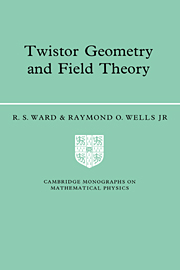5 - Gauge theory
from Part II - Classical field theory
Published online by Cambridge University Press: 08 October 2009
Summary
In the previous chapter we encountered simple gauge theories such as Maxwell—Dirac theory. The key idea in all gauge theories is that of gauge invariance. The word ‘gauge’ is really a misnomer: it arose as a result of an unsuccessful attempt by H. Weyl to unify general relativity and Maxwell theory. This involved tampering with the local length scale in space-time, that is, by allowing local conformal rescalings of the metric; hence the word ‘gauge’, in the sense of ‘measurement scale’. A more accurate term would be ‘phase invariance’, since the basic transformation in Maxwell theory is ϕ ↦ eiΛϕ.
The field equations that we deal with in this book are classical (that is, nonquantum); they describe the propagation of classical fields through space-time. This provides, at best, an approximation to physical reality: for greater accuracy one has to go to the corresponding quantum field theory, in which the various fields become operator-valued (they act on a suitable Hilbert space). For example, classical Maxwell–Dirac theory predicts the spectrum of the hydrogen atom; and this prediction is pretty close to, but certainly different from, what is observed in experiments. The corresponding quantum field theory, which is called quantum electrodynamics, makes predictions about (say) the spectrum of hydrogen which have unprecedented accuracy (theory agrees with experiment to something like one part in 1010).
- Type
- Chapter
- Information
- Twistor Geometry and Field Theory , pp. 263 - 285Publisher: Cambridge University PressPrint publication year: 1990



